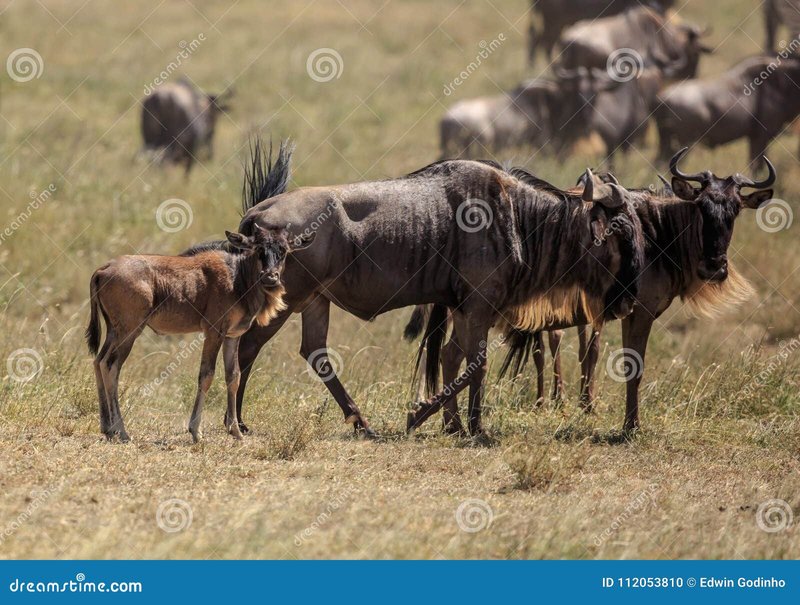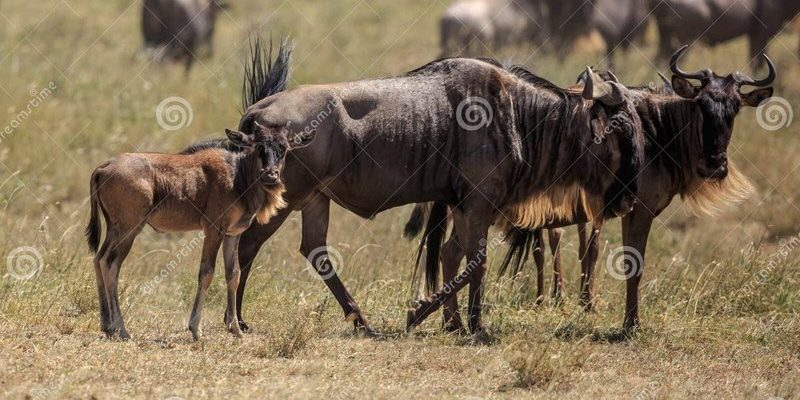
Raising young gnus comes with its own set of challenges and rewards. Like many other animals, they have a unique approach to parenting that ensures their calves grow up strong and ready to face the world. This isn’t just about survival of the fittest; it’s about teamwork, instinct, and a lot of hard work. Let’s break down how these animals raise their young in such a dynamic environment.
Gnu Calf Development: From Birth to Independence
When a gnu calf is born, it’s a moment of joy for the entire herd. The mother typically gives birth in a safe area, away from predators. Honestly, it’s a little like giving birth in a neighborhood watch zone—her friends are nearby, keeping an eye out for danger. The calves are usually born during the rainy season, around January to March, which ensures they have access to plenty of food and water.
A newborn gnu calf is surprisingly mobile. Within just a few hours of birth, they can stand and even run. This quick mobility is crucial for their survival, as predators like lions and hyenas are always lurking nearby. The first few weeks are critical; calves must learn to stay close to their mothers and the rest of the herd while also getting accustomed to the sights and sounds of their new home.
During this formative time, a calf relies on its mother for nutrition. Gnu mothers produce rich milk, packed with nutrients that help their young grow fast. You might wonder why they’re so focused on this initial bonding period. Well, this close relationship builds a foundation of trust and security for the calf, essential as it grows and begins to explore the world beyond its mother’s side.
Maternal Care: Protecting the Young
Gnu mothers are incredibly protective of their calves. You can think of them as the ultimate bodyguards, always on high alert for any signs of danger. They often use vocalizations to communicate with their young and other herd members. A plaintive call can reassure a calf, letting it know, “Hey, I’m right here!”
Here’s the thing: while mothers are responsible for the bulk of care, the entire herd plays a role in raising young gnus. When a mother is grazing or resting, other females in the group keep an eye on the calves. This cooperative parenting approach ensures that if a threat arises, there are multiple adults ready to defend the young ones. It’s a bit like a village raising a child—everyone is involved, and that shared responsibility strengthens herd bonds.
Additionally, gnu mothers are skilled at teaching their calves essential survival skills. As they move to find food and water, the mothers guide their young on where to graze, which areas are safe, and how to navigate through their expansive home. This guidance not only helps the calves survive but also prepares them for life as independent adults.
Social Structure: Learning from the Herd
The social structure of gnu herds is fascinating. Gnus live in large groups that can number in the thousands. This social dynamic plays a significant role in how they raise their young. You might think of it like a school, where younger members learn from older, more experienced ones.
Calves often observe and imitate older gnus. For example, they learn vital skills like how to find water sources, recognize predators, and even understand social cues. This imitation process is crucial because it allows the calves to adapt quickly to their environment. Without the guidance from older herd members, young gnus would struggle to survive.
Interestingly, gnu calves also engage in play, which is essential for their development. They run, jump, and chase each other, practicing their agility and coordination. These playful interactions help build their physical strength and social skills, preparing them for life in the wild.
Migration: A Critical Journey
One of the most remarkable aspects of gnu life is their migration pattern. Each year, they embark on a long journey across the plains in search of food and water. This migration is not just an adventure; it’s a critical part of their survival. Calves must learn the route and what to expect along the way, and this is where their mothers play a vital role.
During migrations, mothers keep their calves close, using the safety of the herd to protect them. The herd’s movement also provides a learning opportunity for the young. As they travel, they observe older gnus navigating challenges such as river crossings or avoiding predator territories. It’s a live-action course in survival skills that’s hard to replicate in any classroom!
Calves often witness the importance of teamwork during migration as well. They learn that sticking together as a herd is essential for safety. This experience builds camaraderie among the young and teaches them the value of community, which becomes crucial when they eventually lead their own families.
The Challenges of Parenting in the Wild
Raising young gnus in the wild isn’t always easy. Predators pose a constant threat, and harsh environmental conditions can make survival tough. Mothers must remain vigilant and quick on their feet to protect their young, often putting themselves in harm’s way.
Weather also plays a role. During droughts, food and water become scarce, forcing mothers to travel longer distances. This can be exhausting for both the mother and calf. Honestly, imagine going for a long hike with a toddler—it’s a tough job! Mothers must ensure their young remain nourished and hydrated, even when resources are limited.
And then there are the challenges posed by human activity. Habitat loss and poaching can disrupt natural migration patterns and endanger gnu populations. Mothers face stress from these changes, as they must adapt to new dangers while still providing for their calves. This reality emphasizes the importance of conservation efforts to protect these majestic animals and their way of life.
The way gnus raise their young is a captivating mix of instinct, cooperation, and resilience. From the moment a calf is born, it’s guided by its mother and the entire herd, learning the ropes of survival in a challenging environment. This community-based approach not only fosters strong bonds within the herd but also equips the next generation with the skills they need to thrive.
As we reflect on the nurturing habits of gnus, we gain insight into the importance of community in raising young animals—something that resonates beyond the wild. Protecting these remarkable creatures isn’t just about saving a species; it’s about preserving the intricate balance of life on Earth. So, next time you think about parenthood in the animal kingdom, remember the gnu, and the incredible lengths they go to raise their young amidst the wild challenges they face.

